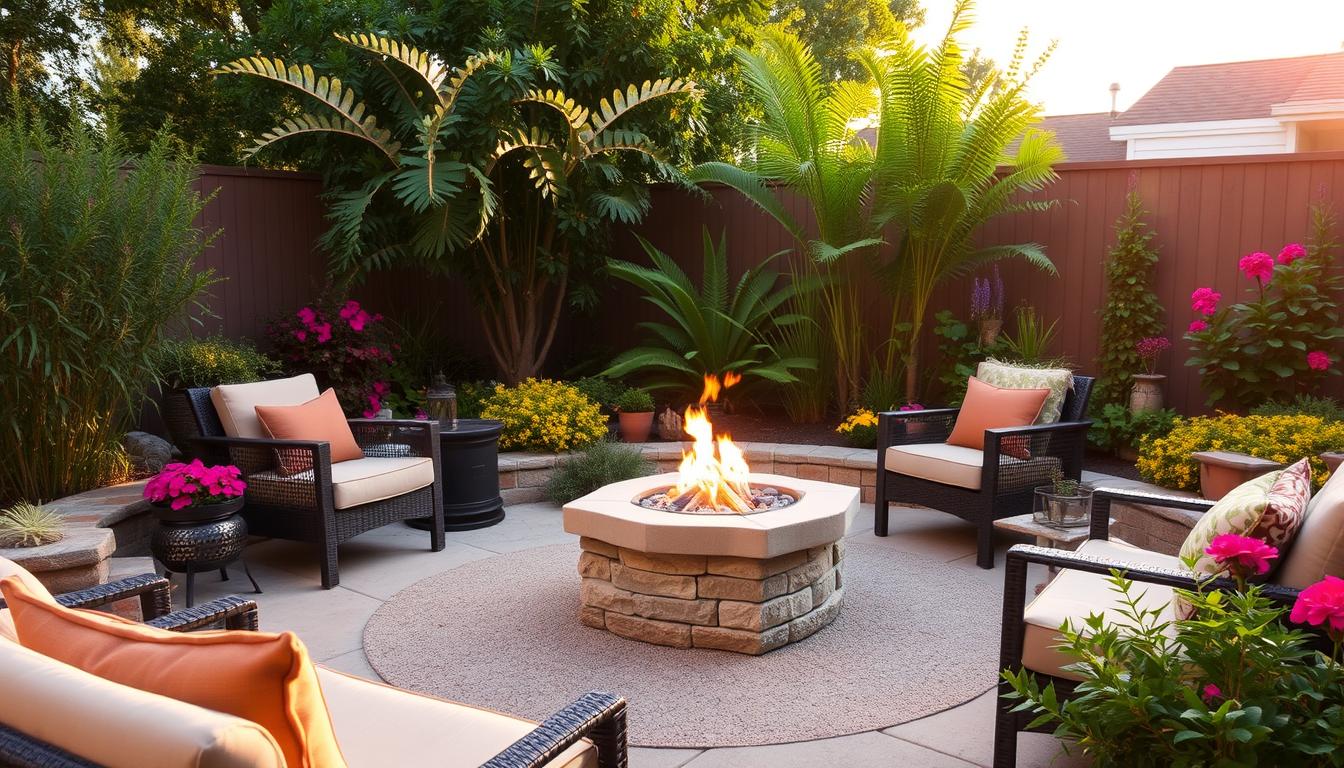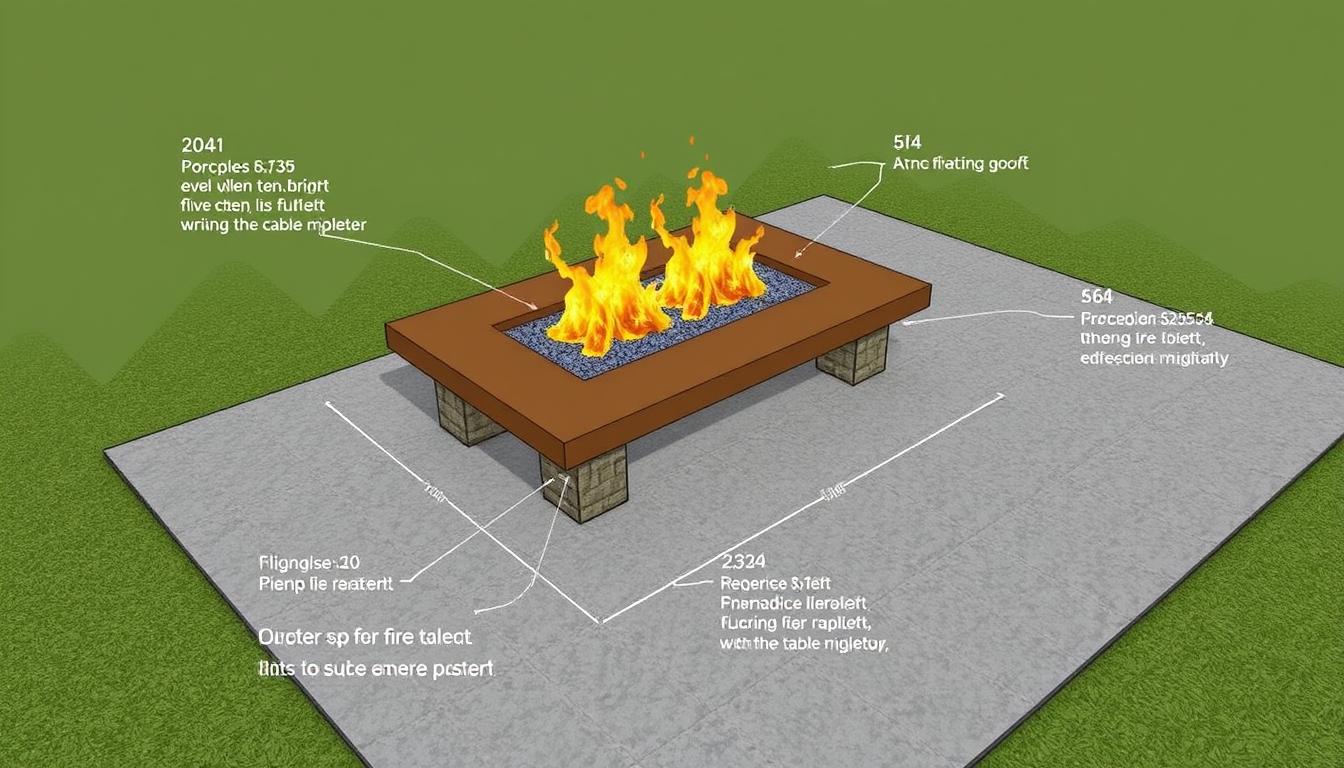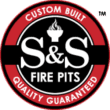Fire pits have been a cornerstone of human gathering and warmth for centuries. Today, they not only serve as a source of heat but also as a focal point in outdoor living spaces, enhancing the ambiance and extending the usability of your yard beyond the warmer months.
Selecting the ideal fire pit involves considering several key factors, including the available space, intended use, and safety requirements. The size of your fire pit significantly impacts its heat output and how well it integrates with your existing outdoor design elements.
We understand that a well-chosen fire pit can transform your outdoor area into a cozy, inviting oasis. By considering these factors, you can create a warm and welcoming living space that is perfect for gatherings and relaxation.
Understanding Fire Pit Basics
The size of your fire pit is a critical factor that influences both its functionality and aesthetic appeal. We understand that choosing the right size fire pit can be daunting, but it’s essential for creating a warm and inviting outdoor space.
Its size plays a significant role in its type and functionality. A portable fire pit is typically smaller and perfect for those who prefer a movable heat source or have limited space. On the other hand, larger fire pits like Prism Hardscapes are usually stationary and can serve as a centerpiece for a more intimate space.
Why Size Matters for Your Outdoor Fire Pit
The size of your fire pit directly impacts its heat output, fuel consumption, and overall visual impact in your outdoor setting. Here are key considerations:
- Smaller fire pits (under 36 inches) are ideal for limited spaces and intimate gatherings, offering portability and easier maintenance.
- Medium-sized pits (36-45 inches) strike a balance between heat output and space efficiency, accommodating small to medium gatherings.
- Larger fire pits (over 45 inches) create dramatic flame presentations and provide significant heat, but require more substantial outdoor areas and increased fuel consumption.
Understanding the relationship between fire pit size and functionality helps ensure you select a model that meets your specific outdoor entertainment needs.
Measuring Your Outdoor Space
Accurate measurement of your outdoor space is vital for determining the right size of fire pit for your patio or backyard. To start, you need to assess the available space where you plan to install your fire pit. This involves considering the overall layout of your yard, including any existing features such as patio furniture, walkways, and landscaping elements.
Determining Available Space for Your Fire Pit
When measuring your outdoor area, it’s crucial to account for any obstacles or features that could impact fire pit placement. Consider the location of trees, gardens, and other outdoor structures. You should also think about the seating arrangement you plan to have around your pit. Ensuring there’s enough clearance for comfortable seating and movement around the fire is essential.
Calculating Clearance Requirements
To ensure safety, your fire pit should be placed at a safe distance from any flammable structures or vegetation. Ideally, it should be 15 to 25 feet away from your home, vehicle, and other outdoor structures. Additionally, consider the prevailing winds to prevent smoke from blowing into neighboring properties. For more detailed guidance on choosing the right fire pit, you can refer to our comprehensive fire pit buying guide.
How to Choose the Right Size and Style Fire Pit for Your Outdoor Space

Selecting the ideal fire pit for your outdoor space involves considering both size and style to ensure a perfect blend of functionality and aesthetics. We understand that the right fire pit can elevate your outdoor living experience, providing warmth, ambiance, and a gathering point for family and friends.
Small Fire Pits (Under 36 inches)
Small fire pits, typically under 36 inches in diameter, are perfect for intimate settings, balconies, or small patios. They are often used more for decoration than as a primary heat source. These compact fire pits can add a cozy ambiance to your outdoor space without overwhelming it.
Medium Fire Pits (36-45 inches)
Medium fire pits, ranging from 36 to 45 inches in diameter, offer versatility for most residential settings. They provide adequate heat while accommodating 4-8 people comfortably, making them ideal for small to medium-sized gatherings. These fire pits strike a balance between functionality and space efficiency.
Large Fire Pits (Over 45 inches)
Large fire pits, measuring over 45 inches in diameter, are perfect for spacious backyards and commercial settings. They provide reliable heat and can serve as dramatic focal points, accommodating larger groups of 8-12 people. These larger fire pits are ideal for those who frequently host gatherings or parties.
When choosing the right size fire pit, consider whether you’re primarily using it for ambiance, cooking, or as a significant heat source, as each purpose may require different dimensions. The right size fire pit should complement your outdoor space while providing the functionality you need for your specific entertainment style.
- Small fire pits under 36 inches are perfect for intimate settings, balconies, small patios, or as decorative elements in larger landscapes.
- Medium fire pits ranging from 36-45 inches offer versatility for most residential settings, providing adequate heat while accommodating 4-8 people comfortably.
- Large fire pits exceeding 45 inches create dramatic focal points for spacious outdoor areas and can serve as gathering spots for larger groups of 8-12 people.
- When selecting size, consider whether you’re primarily using the fire pit for ambiance, cooking, or as a significant heat source, as each purpose may require different dimensions.
- The right size fire pit should complement your outdoor space while providing the functionality you need for your specific entertainment style.
Fire Pit Types and Their Size Considerations
The type of fire pit you choose significantly impacts its size and overall functionality. Different fire pits are designed with unique features that affect their size, fuel efficiency, and the overall experience they provide.
Gas Fire Pits
Gas fire pits are a popular choice for their ease of use and clean operation. They offer precise flame control and are available in sizes typically ranging from 24-60 inches, depending on the BTU output needed. This makes them suitable for a variety of outdoor spaces.

Propane Fire Pits
Propane fire pits provide portability and flexibility in placement, with most models designed in the 30-48 inch range to accommodate standard propane tanks. They are ideal for those who want to enjoy a fire pit in different locations.

Wood-Burning Fire Pits
Wood-burning fire pits are known for their traditional charm and ability to produce intense heat. They tend to be larger (36-48 inches) to accommodate wood logs and ensure proper air circulation, making them a great choice for those seeking a classic outdoor fire experience.
When choosing a fire pit, consider how the fuel type interacts with size, as this relationship significantly impacts both performance and safety.
Fire Pit Styles and Their Space Requirements
Fire pits come in various styles, each with its unique characteristics and space requirements. The right style can enhance your outdoor space, creating a focal point that complements your patio design.
Fire Bowls
Fire bowls are ideal for areas with limited space, featuring shallow, bowl-shaped shells that showcase the flames. They typically range from 24-40 inches in diameter, offering a classic look that works well in various outdoor settings.

Fire Tables
Fire tables combine functionality with ambiance, generally measuring 36-60 inches in length or diameter. They provide ample surface area for drinks and small plates, making them perfect for entertaining.

Fire Columns
Fire columns present a vertical design option, usually 15-24 inches in diameter but 30-60 inches tall. They are ideal for smaller patios where floor space is limited and can be used to illuminate an outdoor walkway.

The style you choose should complement your existing outdoor design aesthetic while meeting your practical needs for heat, light, and entertainment. Consider how each style integrates with your outdoor furniture arrangement and overall patio design to create a cohesive look.
Creating the Ideal Seating Area Around Your Fire Pit
We understand that creating the ideal seating area around your fire pit is crucial for both safety and comfort. A well-designed seating arrangement not only enhances the aesthetic appeal of your outdoor space but also ensures that you and your guests can enjoy the fire pit without compromising on safety or comfort.
Optimal Seating Distances for Round Fire Pits
For round fire pits, arranging seating in a circular pattern is recommended to promote conversation and maintain an equal distance from the heat source for all guests. We suggest maintaining a distance of at least 7 feet from the edge of the fire pit to the seats. This allows for ample legroom and a safe distance from the heat. For a round fire pit with a diameter of 36 inches, the total diameter needed for comfortable seating would be approximately 15 feet.
Optimal Seating Distances for Square Fire Pits
Square fire pits work best with seating arranged in a square or rectangular configuration, typically with chairs or benches on each side. Similar to round fire pits, maintaining a distance of at least 7 feet between the fire pit edge and seating is advisable. If you plan to include a pathway around your seating area, consider adding another 3 feet to the total size to allow for easy movement. For example, a square fire pit with 36-inch sides would require a total area of at least 15 feet by 15 feet to accommodate seating and a pathway comfortably.
| Fire Pit Shape | Recommended Seating Distance | Total Area Required |
|---|---|---|
| Round | 7 feet from edge | 15 feet diameter |
| Square | 7 feet from edge | 15×15 feet |
By considering these guidelines, you can create a seating area around your fire pit that is both safe and inviting, enhancing your overall outdoor living experience.
Material Considerations for Different Sized Fire Pits
Fire pit materials vary widely, and selecting the right one is key to creating a warm and inviting outdoor space. The material used for your fire pit not only affects its durability but also its overall aesthetic and how well it integrates with your existing outdoor design elements.
When choosing a fire pit, it’s essential to consider the size of the unit and the material it’s made of. Larger fire pits require more durable materials that can withstand intense heat and weather exposure over time.
Durable Materials for Permanent Large Fire Pits
For permanent large fire pits (over 45 inches), we recommend using materials like cast concrete, natural stone, or brick. These materials are not only durable but also provide a sturdy, long-lasting fire pit that can be a centerpiece for your outdoor space. Cast concrete, for instance, offers a robust and weather-resistant option that can be customized to fit various designs.
- Cast concrete provides a robust and weather-resistant option.
- Natural stone offers a natural, elegant look that complements most outdoor designs.
- Brick is another durable option that can withstand high temperatures and adds a classic touch to your outdoor area.
Lightweight Materials for Portable Small Fire Pits
Smaller, portable fire pits (under 36 inches) benefit from lightweight yet durable materials such as aluminum, copper, or thin-gauge steel. These materials ensure that your fire pit remains portable while still providing the warmth and ambiance you desire. Copper, for example, not only is lightweight but also develops a beautiful patina over time, adding to the aesthetic appeal.
- Aluminum is a lightweight and corrosion-resistant option ideal for smaller fire pits.
- Copper offers elegance and durability, with the added benefit of developing a natural patina.
- Thin-gauge steel is another versatile option that balances portability with durability.
Safety Considerations Based on Fire Pit Size
The size of your fire pit directly impacts the safety measures you need to implement around it. As we discussed in previous sections, choosing the right size fire pit for your outdoor space is crucial, and so is ensuring that it’s safely installed and maintained.
Clearance Requirements from Structures and Vegetation
One of the primary safety considerations is maintaining adequate clearance between your fire pit and any surrounding structures or vegetation. Larger fire pits produce more heat and potentially more embers, requiring greater clearance to prevent accidental fires or damage. We recommend a minimum clearance of 15 to 25 feet between your fire pit and any structures, with larger pits necessitating the higher end of this range or more.
| Fire Pit Size | Recommended Clearance |
|---|---|
| Small (Under 36 inches) | 15 feet |
| Medium (36-45 inches) | 20 feet |
| Large (Over 45 inches) | 25 feet or more |
Local Regulations and Permits
Before installing a fire pit, it’s essential to check local regulations regarding fire pit size, fuel type, and placement. Many municipalities have specific requirements to ensure safety and minimize risks. For instance, some areas may restrict the use of wood-burning fire pits or require permits for installation. We advise contacting your local authorities to understand the specific regulations in your area.
“Always verify local codes and regulations before installing a fire pit to ensure compliance and safety.”
By considering both clearance requirements and local regulations, you can enjoy your fire pit while maintaining a safe environment around it.
Conclusion
By now, you should have a clear understanding of how to balance your outdoor space, intended use, and safety requirements for your fire pit. Selecting the right size fire pit involves considering several key factors, including the size of your outdoor space, the type of fuel you’ll be using, and your typical entertaining needs.
Whether you’re hosting intimate gatherings or larger parties, the fire pit you choose should enhance your outdoor living experience. Remember, the fuel type you choose—whether gas, propane, or wood—influences both the ideal size and placement options for your fire pit. Proper clearance around your fire pit, typically 5-7 feet, is essential for both safety and comfort, allowing adequate space for furniture and guest movement.
By thoughtfully considering all the factors outlined in this guide—from space measurements to material selection—you’ll be well-equipped to choose a fire pit that provides warmth and ambiance to your outdoor space for years to come. Our guide has provided you with the necessary tools to make an informed decision, ensuring your outdoor space becomes the perfect setting for relaxation and entertainment.
In conclusion, choosing the right fire pit is a matter of balancing your needs with safety and style. With this guide, you’re now ready to make a confident choice that will enhance your patio or outdoor area, providing a warm and inviting space for years to come.


